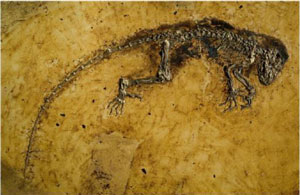"The claim that Darwinius ‘could finally confirm Charles Darwin’s theory of evolution’ tacitly admits that it has not yet been confirmed."
"The orchestrated multimedia blitz over this fossil is almost unbelievable. The paleontologists even got Michael Bloomberg, Mayor of New York, to officiate at the public “launch” of Ida (the cute nickname for the fossil), when it was unveiled—like a new sculpture by a famous artist—to the assembled journalists.
I don’t think I have ever seen such blatantly over-stated claims on a fossil find, and I have seen a few, including one by a major co-author of this paper: Philip Gingerich’s claims for Pakicetus back in 1983. Gingerich had a couple of scraps of a skull of a mammal from Pakistan and claimed it as the evolutionary precursor of whales. He embellished the story with an artist’s drawing of what Pakicetus (“whale from Pakistan”) looked like, with legs becoming flippers, a tail fluke developing and the imaginary creature diving for fish. Cute. Gingerich claimed it was “perfectly intermediate, a missing link between earlier land mammals and later, full-fledged whales”. With such a strong, confident claim from the fossil expert, who could doubt that evolution was true? Seven years later, other paleontologists published a paper describing the rest of Pakicetus and the now almost complete fossil showed that Gingerich’s imagination had really run away with him and the animal was not the missing link he thought it was.
An article in the New York Daily News summarized the claims as follows [numbering added]:
- “… the long-sought missing link between humans and apes.
- “… the fossil of the lemur-like creature dubbed Ida shows it had opposable thumbs like humans and fingernails instead of claws.
- “… hind legs offer evidence of evolutionary changes that led to primates standing upright—a breakthrough that could finally confirm Charles Darwin’s theory of evolution.”
To be fair, the paleontologists did not actually say it was a link between humans and apes, but it is understandable that journalists might interpret what they said in this way. They were claiming that Ida might shed some light on what might have been the connection between mankind’s supposed evolutionary ancestry, as a primate, and non-primates. Dr Jens Franzen said at the press conference at the celebratory “launch” in New York, “We are not dealing with our grand-grand-grandmother, but perhaps with our grand-grand-grandaunt.” Note that Franzen here admits that the creature is not an ancestor of humans, so Ida is not a link between humans and anything, not even with the hypothetical precursors of primates in general.
Lemurs have opposable thumbs (hallux) and fingernails instead of claws too, but almost no-one has considered them to have anything to do with man’s ancestry. Furthermore, like other primates, but not humans, they have them on their feet, which is good for grabbing onto branches, but makes walking upright rather difficult.
Note the careful wording. The authors imagined some hint of characteristics that might be relevant to walking upright tens of millions of evolutionary years later. I could find nothing in the published paper that substantiated this conjecture. And note that this “could finally confirm Charles Darwin’s theory of evolution.”
The fossil has a basic body pattern and toe and finger nails like lemurs, but lacks two features that are peculiar to lemurs: a toilet claw on a toe and grooming teeth (a row of fused teeth), both used for grooming, so it is not “just a lemur”.
Interestingly, a number of evolutionists are criticizing the over-hyping of this fossil. Ann Gibbons, in a commentary on ScienceNow gave air to some criticism: “Many paleontologists are unconvinced. They point out that Hurum and Gingerich’s analysis compared 30 traits in the new fossil with primitive and higher primates when standard practice is to analyze 200 to 400 traits and to include anthropoids from Egypt and the newer fossils of Eosimias from Asia, both of which were missing from the analysis in the paper. ‘There is no phylogenetic analysis to support the claims, and the data is cherry-picked,’ says paleontologist Richard Kay, also of Duke University. Callum Ross, a paleontologist at the University of Chicago in Illinois agrees: ‘Their claim that this specimen should be classified as haplorhine is unsupportable in light of modern methods of classification.’”
The fossil is embedded in shale. The Messel shale has yielded many other interesting and very well-preserved fossils. The shale is supposed to have formed in a lake bed created by volcanic activity. This lake bed, “filled with water, which seemingly, one way or another, accumulated gases that poisoned the animals individually, episodically, or periodically [refs]. The result is a diverse fauna of exceptionally preserved insects, fishes, amphibians, reptiles, birds and mammals [refs].”It stretches the imagination to think what gas could have killed such a wide range of creatures in repeated episodes. ScienceNews reported,
“The scientists believe she was overcome by carbon dioxide gas whilst drinking from the Messel lake: the still waters of the lake were often covered by a low lying blanket of the gas as a result of the volcanic forces that formed the lake and which were still active. Hampered by her broken wrist, Ida slipped into unconsciousness, was washed into the lake, and sunk to the bottom, where the unique conditions preserved her for 47 million years.”
There is a mixture of fossils of terrestrial and aquatic creatures. Did carbon dioxide gas kill fish as well? It would have to be a prolonged period of carbon dioxide blanketing to de-oxygenate the water for the fish to be killed. And such fish would bloat and float, which is not conducive to being buried and preserved/fossilized." CMI
And God made the beast of the earth after his kind,
Genesis 1:25

